Indexed In
- Genamics JournalSeek
- Academic Keys
- JournalTOCs
- China National Knowledge Infrastructure (CNKI)
- Access to Global Online Research in Agriculture (AGORA)
- Centre for Agriculture and Biosciences International (CABI)
- RefSeek
- Directory of Research Journal Indexing (DRJI)
- Hamdard University
- EBSCO A-Z
- OCLC- WorldCat
- Scholarsteer
- SWB online catalog
- Publons
- Euro Pub
- Google Scholar
Useful Links
Share This Page
Journal Flyer

Open Access Journals
- Agri and Aquaculture
- Biochemistry
- Bioinformatics & Systems Biology
- Business & Management
- Chemistry
- Clinical Sciences
- Engineering
- Food & Nutrition
- General Science
- Genetics & Molecular Biology
- Immunology & Microbiology
- Medical Sciences
- Neuroscience & Psychology
- Nursing & Health Care
- Pharmaceutical Sciences
Research Article - (2023) Volume 14, Issue 4
Storage Evaluation of Vacuum-Packed Smoked Catfish (Clariasgariepinus) Ready-to-Eat (RTE) Products
Pia Amabelle Flores1*, Bryan Bretana2, Leanne Jay Manceras3 and Zaibel Rose Tamon32Department of Biology, College of Science and Mathematics, University of Southern Mindanao, Cotabato, Philippines
3Department of Food Technology, College of Human Ecology and Food Science, University of Southern Mindanao, Cotabato, Philippines
Received: 24-Feb-2023, Manuscript No. JFPT-23-20012; Editor assigned: 27-Feb-2023, Pre QC No. JFPT-23-20012 (PQ); Reviewed: 13-Mar-2023, QC No. JFPT-23-20012; Revised: 20-Mar-2023, Manuscript No. JFPT-23-20012 (R); Published: 27-Mar-2023, DOI: 10.35248/2157-7110.23.14.1010
Abstract
Smoked catfish (Clarias gariepinus) prepared in three different forms were evaluated under storage of one-month. Sensory evaluation was based on appearance, aroma, texture, fishy aftertaste and general acceptability. Microbiological analysis was also compared using Standard Plate Count (SPC), Escherichia coli, and Salmonella sp. Results showed significant difference in appearance of smoked whole catfish in the first week of storage. Acceptability of smoked- beheaded- filleted was significantly different at fourth-week of storage. Microbiological analysis showed no detectable level at critical limit. Lower SPC was found in smoked filleted-skinned. The study indicated vacuum-packaging under frozen storage can improve keeping quality and safety of ready-to-eat smoked catfish products.
Keywords
Storage evaluation; Vacuum- packaging; Smoked fish; Ready-to-eat products
Introduction
Fish is an important source of protein for municipal sectors both in marine and inland areas. In the Philippines the Fisheries Situationer (2019) reports 156,000 metric tons just for inland-based fish production which supports food security in rural areas. Total fish consumption consistently increased to 122% from 1990 to 2018 as reflected in the continuous growth in both capture fisheries and aquaculture production (State of World Fisheries and Aquaculture, 2020). This can be attributed to the emerging health-related disease that is why consumers are shifting to fish meat that compliments healthier lifestyle to help boost their immune system.
The African catfish (C. gariepinus) is found in inland water bodies which serves as important food source in inland fisheries. It has gained popularity as food fish because of its tender and delicate excellent taste. Catfish is low calorie, high protein food fish that is a source of nutrients and minerals, including thiamine, cobalamin, selenium, omega-3 and omega-6 fatty acids. This type of fatty acids reduces the accumulation of low-density lipoprotein which in turn lowers the risk of cardiovascular diseases. Being considered as healthy and quite preferred food fish in inland-based fisheries, the prospects of fish processing can address food security in rural communities. Fish processing technology is not limited to the conversion of raw material into a product, further it also tests the product for consumer’s acceptance, quality and most importantly food safety so that the fish product can be consumed for longer duration of time. The present study explored evaluation of smoked catfish, C. gariepinus comparing three different preparations with vacuum-packaging.
Fish smoking is a kind of preservation method that is used traditionally to preserve fish if freezing or chilling facilities are not adequately available. It makes use of heat treatment by application of smoke to cook the fish to the desired texture and appearance. The resulting product is a ready-to-eat food which can be consumed over a week if sanitation and proper fish processing procedures were observed during the whole process. A desirable smoky flavor and odor is imparted in the end-product which in turn improves sensory qualities such as appearance, taste and overall acceptability of the product [1,2]. The preservative effects of fish smoking have been well-documented. Carboxylic and phenolic components of the smoke contribute to the preservative effect in the smoked fish product [3]. Smoking delays spoilage by inhibiting enzymatic reactions in the fish [4,5]. The action of fish smoking does not only provide a unique smoky flavour but is also responsible for antibacterial action, lowering of pH, and eliminating oxidation in the fish product thus provides longer shelf-life [6-11]. Poor handling and unsanitary conditions of fish smoking pose health hazards to consumers mainly Salmonella and Escherichia coli [12,13]. Processing methods following hygiene and sanitation is an important factor to eliminate contamination of pathogenic microorganisms during the processing time [3,14]. Therefore, this study also examined microbiological analysis of smoked fish products as an important aspect in securing food safety of the smoked fish product. The effect of storage is investigated to address food safety during at long transport or marketing condition. This is also to provide quality assurance in RTE products. That is why, microbiological analyses are important in assessing the food safety of derived RTE products. For instance, incidence of E. coli was isolated from RTE fish products [15]. Occurrence of methicillin-resistant Staphylococcus aureus and methicillin-resistant coagulase-negative staphylococci in salted and smoked fish products in Greece [16]. The present study investigates the different preparation of vacuum-packed smoked catfish, Clarias gariepinus, ready-to-eat products. Thus, the study aims to (1) evaluate the sensory qualities and, (2) examine microbiological analysis of smoked catfish, Clarias gariepinus RTE products.
Methodology
Fish processing
The experiment conducted fish processing at the Food Technology Laboratory, College of Human Ecology and Food Science, University of Southern Mindanao. Fish was procured at a local fish farm owner from Kabacan, North Cotabato. Fish was cleaned and gutted according to sanitary measures. Specifically, the Utility Model-22021050827 was used as reference in producing smoked catfish product in the study herein. The Utility Model relates to “Product of Making Marinated Smoked Catfish and the Process Thereof”
Packaging and storage
Processed RTE products were stored at chilled condition and assessed every week for one month period. Stored RTE products were subjected to sensory evaluation and microbiological analysis. Samples were submitted to USM Central Lab for microbiological analysis.
Sensory evaluation
Sensory evaluation followed descriptive method for one month duration, once per week. Same panelists were assigned in the four sets of sensory evaluation of the product to maintain consistency and eliminate bias in the product. Products were assessed in terms of flavour profile (sweetness, sourness, bitterness, saltiness, and taste), other extrinsic qualities (aroma, texture, palatability and appearance) and general acceptability [3].
Storage evaluation
Processed RTE products were stored at chilled condition and assessed every week for one month period. Stored RTE products were subjected to sensory evaluation, microbiological analysis, proximate composition and nutritional composition. Samples were submitted to USM Central Lab for microbiological analysis, USMARC for proximate composition and Food Technology Lab for nutritional composition.
Statistical analysis
Data obtained from the experiment was analyzed using one- way ANOVA after homogeneity of variance test using Statistical Package for Social Sciences (SPSS). Significant differences were considered at p<0.05 confidence level. Turkey’s Test was used to identify differences between experimental groups.
Microbiological analysis
In this study, indicator organisms such as Escherichia coli and Salmonella are used to investigate microbial quality of the product. Presence of Escherichia coli in food indicates the probable contamination of food products with sewage of human or animal origin. On the other hand, Salmonella indicates either lapses in sanitation or fish were harvested from contaminated waters [17,18]. RTE samples were evaluated because these pathogens are widely risked stored food products.
Standard plate count: All samples were analyzed by Central Laboratory, University of Southern Mindanao. The bacterial count was calculated per one gram of sample and expressed as mean cfu/g sample. For this component, the study will focus on determining TPC (Total Plate Count). TPC is an important factor to indicate microbial load of possible spoilage. Procedure for SPC was done using pour plate method [19]. Samples were serially diluted were properly mixed with medium, allowed to set and incubated at 35ºC and 37ºC for 24 hrs. The number of colonies on the plates was counted. Colonies were sub-cultured to further screen presence of indicator organisms
Escherichia coli: For enumeration of coliforms and fecal coliforms, subcultures were inoculated in 2% Brilliant Green Bile Broth (BGLBB). The plates were incubated at 35ºC and 37ºC for 24 hrs. Colonies with pinkish red growth having a metallic sheen or reflection confirms the presence of Escherichia coli.
Salmonella: About 10 mL of sub-culture was selectively enriched into the 100 mL sterilized Selenite Cystine Broth and incubated again at 37ºC for 24 hrs-48 hrs. After incubation, 1 loopful inoculum from the selective enrichment culture was streaked unto the pre-incubated Bile Salt Agar plate. Typical Salmonella spp. produces brown, grey, or black colonies on BSA agar
Data Analysis: Data obtained from the microbial load readings are compared with every treatment. Results from microbial analysis were inspected and checked if critical limits or other food safety measures are complied. In this case, FDA food safety basis were used as reference. Recommendations are then provided for basis.
Results and Discussion
Three methods of vacuum- packaging RTE products were evaluated in this study for smoked catfish RTE products (Figure 1). These correspond to different forms of smoked catfish under vacuum- packed frozen storage: (1) SF- Smoked Filleted; (2) SFB- Smoked Filleted with Bone and, (3) SW- Smoked Whole gutted catfish. Stored frozen RTE products are subjected to sensory evaluation in 4-week duration to assess flavor profile and acceptability at one- month frozen storage period.
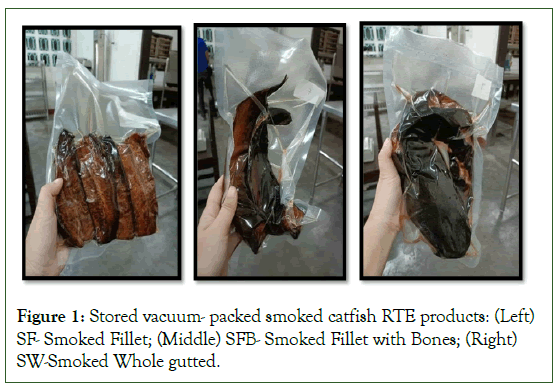
Figure 1: Stored vacuum- packed smoked catfish RTE products: (Left) SF- Smoked Fillet; (Middle) SFB- Smoked Fillet with Bones; (Right) SW-Smoked Whole gutted.
Packaging of smoked catfish RTE products was observed at 300 g-400 g per pack. Prior to sensory evaluation, frozen packed products were steamed and served to panelists. We would like to determine if storage affected individual characteristic of the product itself. Data was analyzed using one-way ANOVA and Tukey’s Test. Significant differences were observed at p<0.05. Significant differences are marked with asterisk in subtitles and boxed letters in the graphical representations.
Storage and appearance
Figure 2 showed results on the appearance of RTE products. Findings in the analysis showed that the smoked whole catfish frozen product were significantly appealing in first week of storage but is also comparable to fourth week of storage (p<0.05). However, results in the appearance of the product do not significantly differ between 2nd to 4th week of storage period (p<0.05). This could mean that for smoked whole catfish frozen product, appearance is significantly preferred until first week storage condition.
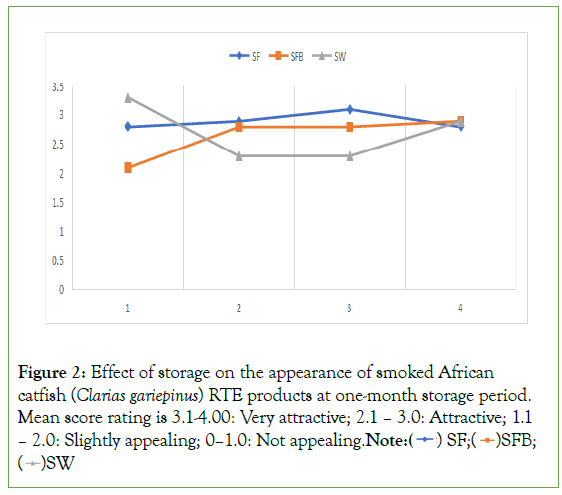
Figure 2: Effect of storage on the appearance of smoked African
catfish (Clarias gariepinus) RTE products at one-month storage period.
Mean score rating is 3.1-4.00: Very attractive; 2.1 – 3.0: Attractive; 1.1 – 2.0: Slightly appealing; 0–1.0: Not appealing. Note: ( ) SF;(
) SF;( )SFB;
(
)SFB;
( )SW
)SW
An opposite trend is observed in smoked fillet with bones RTE products. Smoked filleted with bones resulted to significantly better appearance after fourth week storage. But this result was comparable to 2nd and 3rd week storage period. Interestingly, results do not significantly differ from 1st to 3rd week of storage. Only first week and fourth week of storage period were distinctly obtained significantly different results. This could suggest that appearance might have improved during storage for smoked filleted with bones frozen products.
Storage and aroma
Results showed storage affects aroma in the smoked fish products (Figure 3). The findings indicate that there are no significant differences in the mean scores of aromas in all treatments as storage prolongs in all RTE products (p<0.05). Aromatic flavor was comparable in all treatments which could suggest that the smoking procedure allowed uniform quality for all smoked catfish products.
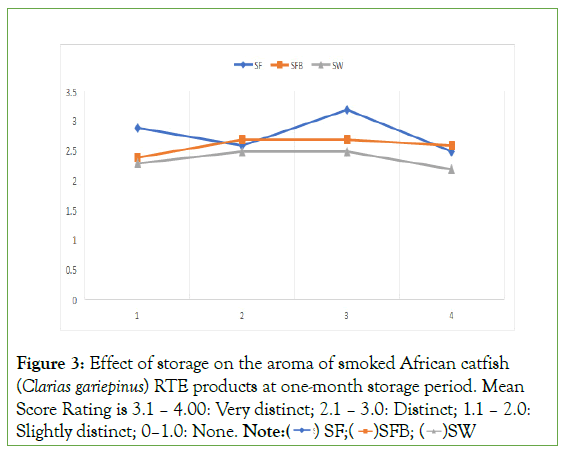
Figure 3: Effect of storage on the aroma of smoked African catfish
(Clarias gariepinus) RTE products at one-month storage period. Mean
Score Rating is 3.1 – 4.00: Very distinct; 2.1 – 3.0: Distinct; 1.1 – 2.0:
Slightly distinct; 0–1.0: None. Note: ( ) SF;(
) SF;(  )SFB; (
)SFB; ( )SW
)SW
Sensory ratings for aroma were maintained between 2.0-3.0 mean ratings, except for Smoked Fillet (SF) with a slight increase in aroma found at the 3rd week storage. A common trend was found for Smoked Fillet with Bones (SFB) and Smoked Whole (SW) products. Both SFB and SW frozen products slightly increase in aromatic flavor from 1st to 3rd week of storage but then slightly decreases in the fourth week of storage. This was not the case of SF products since varied results were observed but still results also decreased in the fourth week of storage.
Shelf-life and sourness
Sourness was not developed during storage (Figure 4). Findings showed no significant differences in sourness parameter of the product (p<0.05). Sensory rating did not surpass the line of 2.0 marks, which means sourness was not developed during storage in all RTE products.
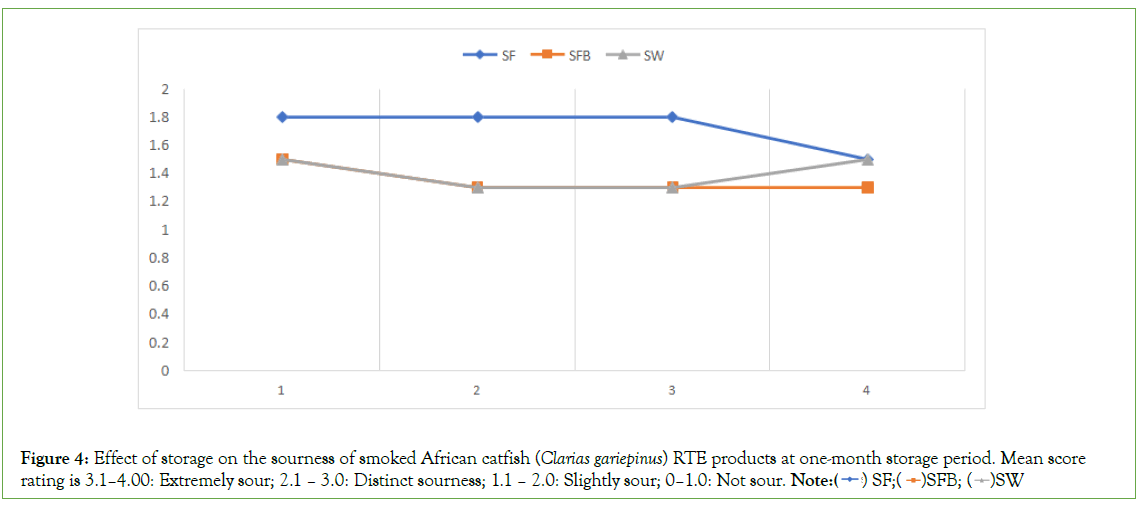
Figure 4: Effect of storage on the sourness of smoked African catfish (Clarias gariepinus) RTE products at one-month storage period. Mean score
rating is 3.1–4.00: Extremely sour; 2.1 – 3.0: Distinct sourness; 1.1 – 2.0: Slightly sour; 0–1.0: Not sour. Note: ( ) SF;(
) SF;(  )SFB; (
)SFB; ( )SW
)SW
Surprisingly, both SFB and SW obtained identical mean rating for sourness from 1st to 3rd week of storage. On the other hand, SF has slightly higher values of mean rating in sourness compared to SFB and SW. Sourness could also indicate spoilage if distinct sourness were manifested in the ratings, then there could be a probable cause that spoilage have developed. In contrast, the values obtained in the study showed decreasing trend in all treatments as storage prolongs. This could mean that proper sanitation was observed during the processing of RTE products.
Storage and texture
Texture showed varying effects from storage (Figure 5). Findings in terms of texture showed significant observations for smoked fillet frozen products. Smoked fillet frozen products is significantly higher in the 1st week of storage compared to 4th week of storage (p<0.05). But texture did not significantly differ from 1st to 3rd week of storage (p<0.05). It can be inferred that texture is significantly affected in the fourth week of storage for smoked filleted frozen product.
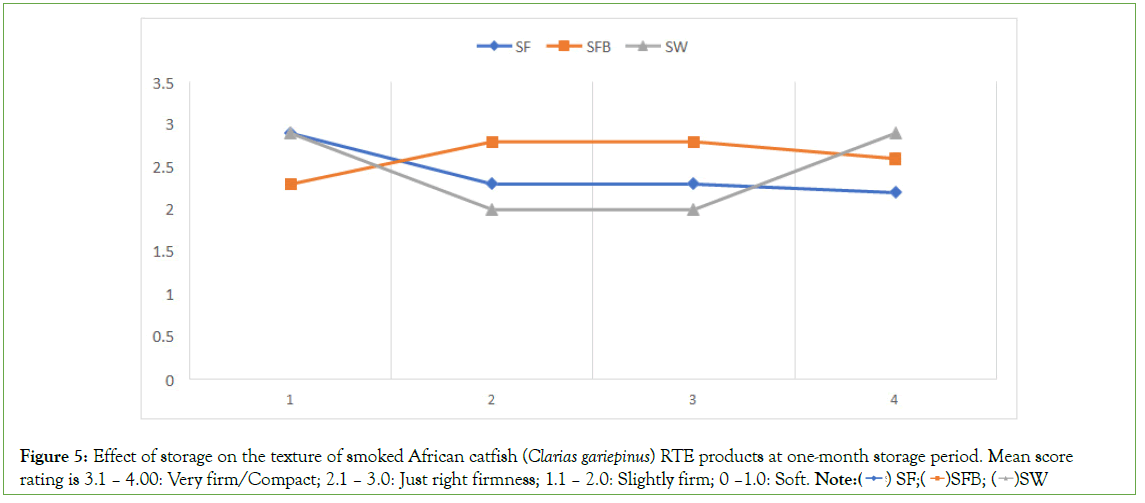
Figure 5: Effect of storage on the texture of smoked African catfish (Clarias gariepinus) RTE products at one-month storage period. Mean score
rating is 3.1 – 4.00: Very firm/Compact; 2.1 – 3.0: Just right firmness; 1.1 – 2.0: Slightly firm; 0 –1.0: Soft. Note: ( ) SF;(
) SF;(  )SFB; (
)SFB; ( )SW
)SW
In contrast to smoked filleted and smoked whole catfish frozen products wherein decreasing ratings were observed as storage prolongs, this is not the case of SFB products. For SFB frozen products, slight increase in texture preference were found in the ratings as storage prolongs up to 3rd week of storage. Slight decrease in rating were also found at fourth week of storage. In this case, packaging might have affected the texture as storage prolongs particularly in smoked filleted frozen product.
Storage and taste
The findings indicated no significant difference among treatments as shown in Figure 6 (p<0.05). However, a similar trend can be observed for SF and SFB frozen products. Slight increase in ratings were observed from 1st to 3rd week of storage. This followed slight decrease in ratings after the fourth storage sensory evaluation. This is not the case of SW frozen products wherein slight decrease in rating were observed at 2nd week of storage. Interestingly, identical result was found in the mean ratings for SW frozen products from 2nd week to 4th week of storage.

Figure 6: Effect of storage on the taste of smoked African catfish (Clarias gariepinus) RTE products at one-month storage period. Mean score
rating is 3.1 – 4.00: Very satisfying; 2.1 – 3.0: Satisfying; 1.1 – 2.0: Slightly satisfying; 0- 1.0: Poor taste. Note: ( ) SF;(
) SF;(  )SFB; (
)SFB; ( )SW
)SW
It could be suggested that for SF and SFB frozen products, taste slightly changes at fourth week of storage. Also, the trend exhibited by SFB product in terms of taste is somehow similar to the trend in terms of texture. If that could be the case, then texture might have affected the taste of the product.
Storage and fishy after-taste
Findings shown in Figure 7 indicated no significant differences in fishy after taste among all the treatments as the storage prolonged (p<0.05). None of the treatments exceeded line of 3.0 rating which could suggest that fishy aftertaste among products was at tolerable limit. This coincides with observation in sourness parameters wherein sourness was also found in incremental values and did not develop as storage prolongs.
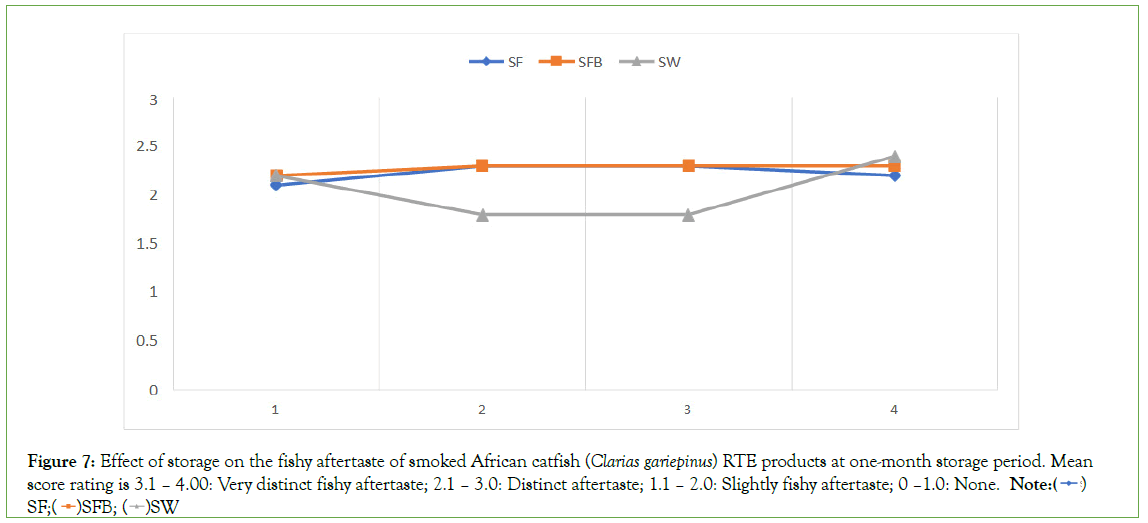
Figure 7: Effect of storage on the fishy aftertaste of smoked African catfish (Clarias gariepinus) RTE products at one-month storage period. Mean
score rating is 3.1 – 4.00: Very distinct fishy aftertaste; 2.1 – 3.0: Distinct aftertaste; 1.1 – 2.0: Slightly fishy aftertaste; 0 –1.0: None. Note: ( ) SF;(
) SF;(  )SFB; (
)SFB; ( )SW
)SW
Varied results were found in each treatment. An interesting result in SF and SFB products. Wherein, identical result in the mean rating was found from 2nd week to 4th week of storage. Another surprising finding was observed such that same values resulted in 2nd to 3rd week of storage in all RTE frozen products.
Storage and general acceptability
Findings in the general acceptability almost followed similar trends in all treatments (Figure 8). Results in the general acceptability of the product indicated significant difference between packaging and storage in SFB products (p<0.05). Acceptability is significantly higher in 2nd week and 3rd week of storage and significantly lower in 1st week of storage. However, 1st week acceptability is significantly not different with 4th week mean rating. It can be suggested that acceptability can be improved only up to 3rd week of storage.
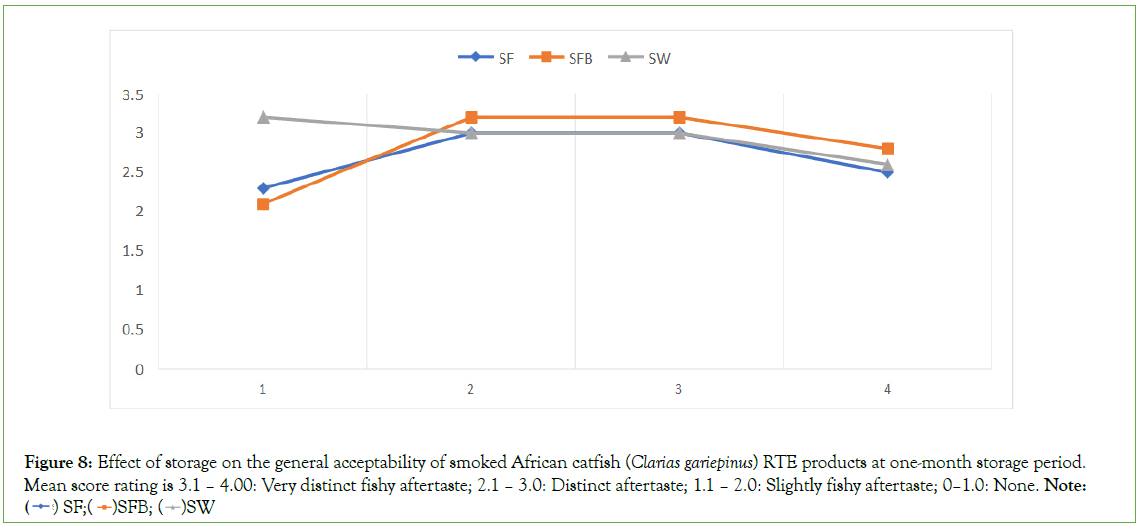
Figure 8: Effect of storage on the general acceptability of smoked African catfish (Clarias gariepinus) RTE products at one-month storage period.
Mean score rating is 3.1 – 4.00: Very distinct fishy aftertaste; 2.1 – 3.0: Distinct aftertaste; 1.1 – 2.0: Slightly fishy aftertaste; 0–1.0: None. Note: ( ) SF;(
) SF;(  )SFB; (
)SFB; ( )SW
)SW
Interestingly, in general, frozen RTE products showed similar patterns in terms of general acceptability as storage prolongs. General acceptability in all frozen RTE products were maintained at mean score rating of 3.0-3.1 in the 2nd and 3rd week of storage and slightly decreased after 4th week of storage.
Another interesting finding is that trends in general acceptability was similar to the trend in taste parameters. It could be noted that the panelist’s preference for general acceptability were highly influenced by their taste preferences. Interesting observations were found in SFB products wherein mean score ratings in 1st to 4th week storage exhibited similar trends for texture, taste and now general acceptability.
Microbial analysis of RTE products
Microorganism’s activity is an important limiting factor in the shelf- life of fish products during storage period (Table 1). Microbial analysis did not exceeded limits set by FDA food standards. The FDA standard for Standard Plate Count (SPC) is reported at 5 × 105 cfu/g, E. coli at 11 MPN/g; Staphylococcus aureus at 103 cfu/g; and Salmonella at undetectable level. From the result of the analysis, freezing was efficient in limiting spoilage in vacuum-packed smoked RTE products.
| 1-Week Storage | 2-week storage | 3-Week Storage | 4-week storage | |
|---|---|---|---|---|
| Smoked Fillet | ||||
| SPC | <1.× 10cfu/g | <1.0× 10cfu/ g | 1.3 × 104 cfu/ g | <1.0 × 10cfu/ g |
| Escherichia coli | <1.0 × 10 MPN/g | <1.0 × 10 MPN/g | <1.0 ×10 MPN/ g | <1.0 × 10 MPN/g |
| Salmonella | <1.0 ×10 cfu/g | <1.0 × 10 cfu/g | <1.0 × 10 cfu/ g | <1.0 × 10 cfu/g |
| Smoked Fillet with Bones | ||||
| SPC | <1.0 ×10cfu/ g | 2.33 ×10 cfu/g | <1.0 ×10 MPN/g | 0.2 ×102 cfu/ g |
| Escherichia coli | <1.0 ×10 MPN/g | <1.0 ×10 MPN/g | <1.0 × 10 MPN/g | <1.0 ×10 MPN/g |
| Salmonella | <1.0 ×10 cfu/ g | <1.0 ×10 cfu/g | <1.0 × 10 cfu/g | <1.0 x 10 cfu/g |
| Smoked Whole | ||||
| SPC | <1.0 ×10cfu/g | <1.0 × 10cfu/ g | 7.0 ×10 cfu/g | 3.0 × 10 cfu/g |
| Escherichia coli | <1.0 × 10 MPN/ g | <1.0 × 10 MPN/ g | <1.0 × 10 MPN/ g | <1.0 × 10 MPN/g |
NOTE: *<1.0 cfu/g – not detected in the sample.
*<1.0 MPN/g – not detected in the sample.
Table 1: Microbial analysis of smoked C. gariepinus for 1-month frozen storage.
The antimicrobial effect of smoke constitutes, heating during smoking and partially dehydration in addition to the effect of sodium chloride in lowering the water activity of fish muscles thus minimizing the available moisture for microbial growth added with the action of low temperature preservation during refrigeration [20].
This could explain the lowering of microbial count of the frozen smoked products in the present study. Further, the processing methods improve hygienic quality by eliminating pathogenic microorganisms as also observed in the study [14].
Standard Plate Count (SPC)
It can be noted that SFB obtained values beyond undetected levels on the 2nd week and 4th week of storage (2.33 × 105 cfu/g) but still below risk standard set by FDA. It’s the earliest to develop detected levels among other products but still in lesser value compared to SW products. Interestingly, SPC fell on undetected levels in the third week of storage. But, considering reported values, it still reflected that RTE products produced in the study are still safe for consumption. SF developed beyond undetectable count at the 3rd week of storage though it was below FDA standard limit. This later diminished at the 4th week of storage. It can be stated that SFB products were not prone to spoilage. Based on the microbial analysis profile, it can be stated that SF products has the least reported value in SPC as well as the least incidence found of detection. Thus, SF products are least prone to spoilage at 4-week storage period. SW products obtained values beyond undetected limit on the third and fourth week of storage. Slight decreases in detection value were recorded on the 4th week of storage. Incidences of SPC beyond detection limit is higher in SW products. Although, values were still under FDA standard limit for SPC. Thus, we can also say that spoilage was not incurred during storage. From the result gathered, we can state that there is no correlation between SPC and acceptability of the product. SPC remained on levels below FDA set standards considered to have pose health risk. Although, continued analysis could have gathered additional data for the detection of SPC critical levels.
Smoked catfish are traditionally sold without prior packaging. Results of microbial analysis, TPC as the closest association with SPC, it shows that vacuum packagings have a positive effect in the storability of the smoked catfish product. As such, Ricketts (2018) reported higher TPC count of smoked catfish (Clarias gariepinus) in a fish market at 1.2 × 104 cfu/g and increasingly at 2.9 × 105 cfu/g after one week [21]. Even reported higher values of TPC (2 × 104 -2.99 × 105 cfu/g). If we compare to the values in other studies [12,13,17], the result of the present study still shows lower values. Meanwhile, assessed microbiological test of smoked de- boned milkfish in terms of TPC [22]. In this study, the 105 cfu/g TPC count of the refrigerated samples was obtained after 5 days of storage. However, assessed refrigerated smoked C. gariepinus fillets and reported 105 cfu/g at 25 days post-refrigeration used fillet slices which could have improved microbial quality according to TPC [23]. Suggested increase in total bacterial number in smoked catfish fillets during refrigeration storage period may due to loss of phenolic and carbonylic compounds which acts as antibacterial component in smoked fish products [24]. Freezing have been proven to eliminate microorganisms from multiplying at -100ºC and below [25]. Reductions of microbial growth were most evident in sugarcane vinegar-treated frozen smoked fish samples. Demonstrated that vinegar was an effective antimicrobial agent in reducing spoilage bacteria in catfish fillets. The study also cited that 5% acetic acid would be appropriate in reducing bacteria to prolong shelf-life without compromising sensory quality and safety of catfish fillets [26].
E. coli and Salmonella
No E. coli and Salmonella were detected in all samples of RTE products. According to Food Standards, these pathogens should be undetected in the food samples. The absence of E. coli and Salmonella in all RTE product samples is safe for human consumption. There is no correlation in the storability and microbial characteristic of the products. It further shows that smoked catfish were processed and properly, used pathogen-free water and vacuum-packaging maintained products at good storage condition. From the data gathered in this study, freezing is effective in reducing spoilage in smoked catfish products [27,28]. It can be noted that more stable quality of frozen smoked C. gariepinus products. E. coli and Salmonella were not detected after one week of chilled storage which further shows that the methods of processing adhered to food safety measures. It also means that the brand can recommend that the product is still safe to eat within one- month storage if stored frozen.
Akinwumi recorded coliform count at 1 × 104 -1.9 × 105 and Salmonella at 1.2 × 104 for smoked catfish sold in different markets [21]. Both E. coli and Salmonella were absent in the samples during one-month storage duration. Although, acceptable limits by states that acceptable limits of fecal coliform (E. coli) for frozen fish is at <10 MPN/g, these values were not reflected in the result of the study. Low temperature preservation played an important role in the control of microorganisms during storage. It can be suggested that low temperature storage generally inhibit microbial multiplication but can gradually increase when it has adapted to the environment which would suggest what happened to detection of SPC in SW products at 3rd and 4th week of storage [29,30]. In general, all values reflected by SPC in the study fall under food safety levels. The different packaging methods refer to different pre- processing treatments prior to storage of products. In this case, microbial analysis in vacuum-packed samples at 1st week storage reported values below detection limit set for smoked fish by FDA standard which means that no spoilage was incurred. The product is still safe for consumption. This could suggest that safety measures were followed during the processing of the product [31].
Conclusion
In general, result of sensory evaluation showed effects of packaging on the sensory properties of stored smoked fish products. Common trends were observed in the mean score ratings of SF and SFB in terms of taste and general acceptability as storage prolongs. Common incidences of same mean score ratings were exhibited by SFB and SW in terms of sourness and general acceptability particularly on the 2nd and 3rd week storage. SW products has most likely the most preferred mean score ratings on 1st week storage evaluation. SFB products most likely obtained highly preferable mean score ratings at 2nd to 3rd week storage evaluation in most parameters except for appearance and aroma. SFB products tend to exhibit common trend of mean score ratings of most parameters at one- month storage except for appearance and aroma. SF almost exhibit common pattern with SFB products but with slightly lower mean score ratings. There is a common linear pattern of mean score ratings between 2nd and 3rd week of storage in all parameters except for appearance and aroma parameters. In general, the mean score rating obtained in the 2nd week storage was maintained until 3rd week of storage. This is highly evident in all RTE products in all parameters such as sourness, texture, taste, fishy aftertaste and general acceptability. The trend always changes at the 4th week of storage evaluation. Mean score ratings are most likely to drop at the 4th week storage period in SF and SFB products. SW products have observable slight increase at 4th week storage particularly in appearance, sourness, texture, and fishy aftertaste. Although, sensory evaluation is just one way of determining quality of the food product. Another important measure in the shelf- life study is the microbiological analysis of the product at storage. These are then investigated in the next component of the project. The microbial analysis performed for RTE products in the study showed no detection for E. coli and Salmonella. The study implies vacuum- packaging and freezing contributed to the storability of smoked catfish products. Another observation of the study is that the mode of preparation did not caused contamination to the product. It can also be implied that the mode of preparation followed safety measures.
References
- Cardinal M, Knockaert C, Torrissen O, Sigurgisladottir S. Relation of smoking parameters to the yield, colour and sensory quality of smoked Atlantic salmon (Salmo salar). Food Res Int. 2001; 34(6):537-50.
- Clucas IJ, Ward AR. Post-harvest fisheries development: a guide to handling, preservation, processing and quality. Natural Resources Institute. 1996.
- Espejo-Hermes J. Fish Processing Technology in the Tropics. Tawid Publication Manila. 81 - 94:1998.
- Kumolu-Johnson CA, Ndimele PE. Effect of salting, brining and sundrying on the shelf-life of Clarias gariepinus (LACEPEDE). J Res Rev in Sci. 2001; 2:21-5.
- Abolagba OJ, Melle OO. Chemical composition and keeping qualities of a scaly fish tilapia, Oreochromis niloticus smoked with two energy sources. Afr J Gen Agric. 2021;4(2).
- Olokor JO, Ihuahi JA, Omojono FS, Fabiyi BA, Adelomo EO. Hand book of practical Fisheries Technology Division. National Institute of Fresh water Fisheries Research (NIFFR), New Bussa, Niger State. Rem-Thomas press. 2007:13-42.
- Sengor Gf, Kalafatoglu H, Gun H. The determination of microbial flora, water activity and chemical analyses in smoked, canned mussels (Mytilus galloprovincialis L). Turkish J Vet Anim Sci. 2004; 28 (5):793-7.
- Eyo AA. Fish Processing Technology in the Tropics National Institute. Fresh Water Fish Res. (FIFR) New Bussa Nigeria. 2001:66-130.
- Horner WF. Preservation of fish by curing (drying, salting and smoking). Fish processing technology. 1997; 2(1): 21-39.
- Olley JN, Doe PE, Heruwati ES. The influence of drying and smoking on the nutritional properties of fish: An introductory overview. Elsevier London. 1988:1-14.
- Clucas IJ, Ward AR. Post-harvest fisheries development: a guide to handling, preservation, processing and quality. Natural Resources Institute. 1996.
- Ohalete CN, Obiajuru IO, Obiukwu CE, Uwaezuoke JC. Microbiological quality of fried and smoked fish in Owerri, Imo State Nigeria. World J Pharm Sci. 2013; 2(1):1-9.
- Likongwe MC, Kasapila W, Katundu M, Mpeketula P. Microbiological quality of traditional and improved kiln smoked catfish (Clarias gariepinus; Pisces; Clariidae) in Lake Chilwa Basin. Food science & nutrition. 2019; 7(1):281-6.
- Kocatepe D, Turan H, Taşkaya G, Kaya Y. Effects of cooking methods on the proximate composition of black sea anchovy (Engraulis encrasicolus, Linnaeus 1758). 2011; 36(2):71-5.
- Gupta B, Ghatak S, Gill JP. Incidence and virulence properties of E. coli isolated from fresh fish and ready-to-eat fish products. Veterinary World. 2013;6(1).
- Sergelidis D, Abrahim A, Papadopoulos T, Soultos N. Isolation of methicillin‐resistant Staphylococcus spp. from ready‐to‐eat fish products. Lett Appl Microbiol. 2014; 59(5):500-600.
- Ogwan’g VO, Mucai M, Patel T. Investigation of bacteriological quality of smoked fish.2004
- AOAC. Official Methods of Analysis. 15th Ed, Association of Official Analytical Chemists, Washington, DC USA. 2001.
- Lueck E. Antimicrobial Food Additives: Characteristics, Uses, Effects.1980.
- Ricketts AO. Biochemical and Microbiological Assessment of Smoked Dried Clariasgariepinus. 2018.
- Akinwumi FO, Adegbehingbe KT. Microbiological analysis of three of smoked fish obtained from the Ondo State, Nigeria. Food and Public Health. 2015; 5(4):122-6.
- Peralta EM, Palmos GN. Microbiological and sensory evaluation of smoked de-boned milkfish without pre-cooking. Philipp J Sci. 2009; 14(2):92-8.
- El-Lahamy AA, Khalil KI, El-Sherif SA, Mahmud AA. Effect of smoking methods (hot and cold) and refrigeration storage on the chemical composition of catfish fillets (Clarias gariepinus). J Food Process Technol. 2018; 9(10):1-4.
- El-Akeel MT. Chemical, Microbiological and Sensory Evaluation of Hot Smoked Catfish. Fac of Agric Cairo Univ. 1988.
- Connell J. Control of Fish Quality, 2nd ed. fishing news LTD. Surrey. 1995.
- Lingham T, Besong S, Ozbay G, Lee JL. Antimicrobial activity of vinegar on bacterial species isolated from retails and local channel catfish (Ictalurus punctatus). J food Process Technol. 2012; 2(3):25-8.
- Huss HH, Boerresen T, Dalgaard P. Quality and quality changes in fresh fish. FAO, Fisheries Technical Paper. 1995.
- Horner WF. Preservation of fish by curing (drying, salting and smoking). Fish processing technology. 1997; 2(1): 21-39.
- Pelczar C. Microbiology concepts and applications, Mcgraw – Hill, include, New York. 1993.
- Mathiesen AM. The State of World Fisheries and Aquaculture. Food & Agriculture. 2000.
Citation: Flores PA, Bretana B, Manceras LJ, Tamon ZR (2023) Storage Evaluation of Vacuum-Packed Smoked Catfish (Clariasgariepinus) Ready-to- Eat (RTE) Products. J Food Process Technol.14: 1010.
Copyright: © 2023 Flores PA, et al. This is an open-access article distributed under the terms of the Creative Commons Attribution License, which permits unrestricted use, distribution, and reproduction in any medium, provided the original author and source are credited.


